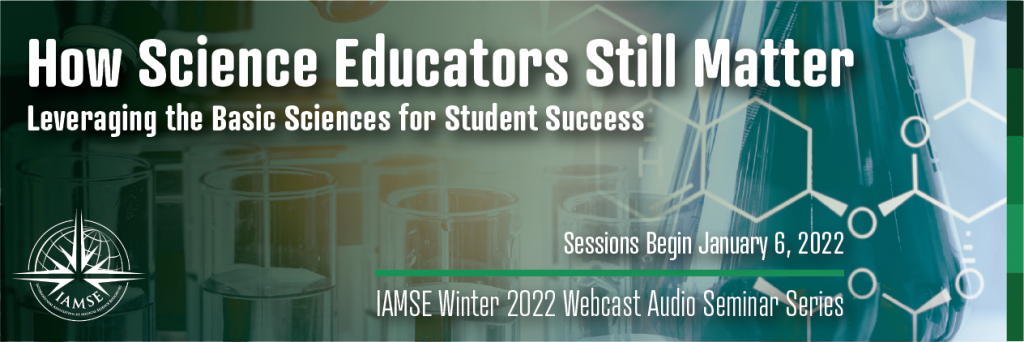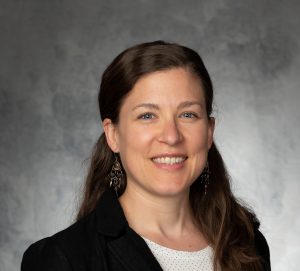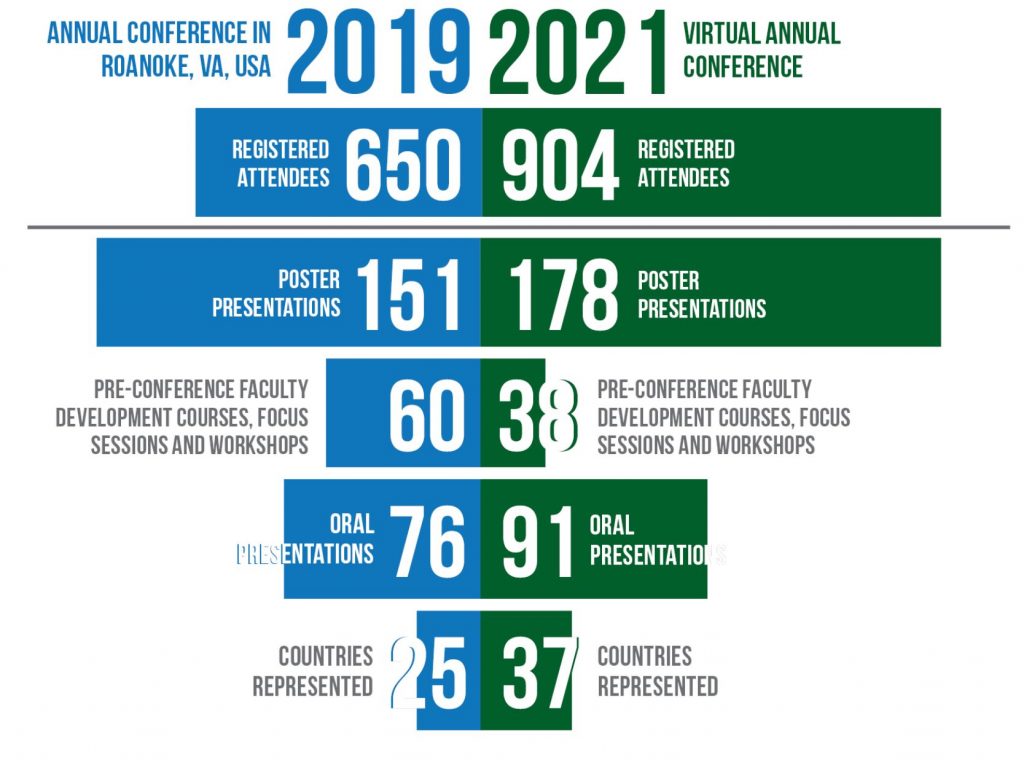[The following notes were generated by Andrea Belovich, PhD.]
The fifth and final session in the Fall 2021 IAMSE Web Seminar Series, “Back to the Future: Maximizing Student Learning and Wellbeing in the Virtual Age,” was presented on September 30th, 2021 by a panel of educators and students. The presentation, “How COVID-19 Transformed Online Teaching and Learning: Or did it?” was co-presented by Dr. Jonathan Wisco, Associate Professor of Anatomy and Neurobiology at Boston University School of Medicine, Dr. Olivia Coiado, Teaching Associate Professor of the Department of Biomedical and Translational Sciences at the Carle Illinois College of Medicine, and Dr. Jaya Yodh (Teaching Associate Professor and Medical Education Facilitator) for the Carle Illinois College of Medicine, and Luke Read, a final-year medical student from Norwich Medical School at University of East Anglia. In this webinar, the presenters shared examples of how their respective programs adapted to the online learning environment precipitated by the SARS-Cov-2 pandemic.
Dr. Wisco began the panel presentation by sharing how the Anatomy course at the Boston University School of Medicine (BUSM) was adapted from the traditional dissection format of the pre-pandemic world into a blended learning format with a greater online learning component. Importantly, Dr. Wisco’s work showed that student outcomes (as measured by feedback and performance on summative assessments) improved from previous years, indicating that the changes made to the program delivery enhanced student learning beyond the traditional in-person format used previously.
Prior to the COVID-19 pandemic, the 9-week BUSM Anatomy course involved thrice weekly lectures, a weekly two-hour dissection for each student within a larger group, and continuing dissection/recitation events in the afternoon, with M-IV students acting as teaching assistants and prosectors. Students also relied on the ability to access the anatomy lab to finish dissections and study from their cadaver donors outside of scheduled classes. However, in response to the pandemic, BUSM’s guidelines resulted in a reduction to in-person contact hours for students and eliminated their access to the anatomy lab outside of class. The challenge then faced by Dr. Wisco and his team was how to translate this traditional dissection course to a safe, online learning experience with minimal student-educator contact. Delivery of didactic lectures remained unchanged, but anatomy students now only had two hours each week to study in the anatomy lab.
To meet this challenge, the BUSM anatomy course was changed to a completely prosection-based paradigm combined with several online resources to help students prepare for their two-hour weekly lab session. MS-IV students were mobilized to prosect all cadaver donors and set up study materials, with the afternoon recitations and material reviews delivered virtually using Zoom. To help students prepare for labs, Dr. Wisco utilized flipped learning and created lectures using images from the Rohen and Yokochi Anatomy Atlas and the Complete Anatomy software from Eslevier. A detailed structure guide created by graduate students in the Boston University Masters of Anatomical Sciences Educator Pathway was provided to the students. During the in-person lab sessions, students were further divided into groups (Pods) that rotated between 6 cadaver donor stations, with 2-3 students receiving instruction from station prosectors at a time. In terms of assessment, the BUSM Anatomy course did not administer practical exams using cadaver donors, but rather utilized images from Complete Anatomy and Rohen & Yokcohi’s Atals to create “hotspot” questions in Examsoft requiring students to click on the area of the image specified by the assessment question. Formative assessments were also used extensively, consisting of in-lab quizzes with first-, second-, and sometimes third-order questions asked by prosectors.
Dr. Wisco next shared data regarding the effectiveness of each of the learning resources provided to students. Data were collected using a Likert-scale questionnaire, a grounded theory thematic analysis of student free-response questions (collected from 80/160 students), and a focus group of 16 students. The results showed that students believe the pre-lab guides were useful, but were used mostly as post-lab review, depending on the instruction received in the lab. Surprising to Dr. Wisco was the high value students placed on the Zoom recitation sessions, stating that the feedback they received during the recitations was imperative to their success in the course. Indeed, students on average scored 10% higher on all exams administered compared to the previous year’s traditional dissection course. With these results in mind, Dr. Wisco stated that the BUSM Anatomy course will incorporate more opportunities for in-person dissection as safety guidelines relax, but will retain the use of Zoom-mediated lab recitations. Additionally, as BUSM is moving to a systems-based and fully integrated curriculum, the addition of team-based learning (TBL) to the lab will help utilize the best of both worlds.
Dr. Wisco concluded his section of the webinar with major lessons learned by emphasizing the importance of establishing a culture of trust, with clear objectives and expectations, along with activities that help students learn and perform well on exams. He also shared the importance of reassessing how educators assess students, and ensure that assessments are reflective of students’ learning activities. He further shared the observation that faculty are no longer the primary source of information, but the ability of faculty to provide formative and timely feedback to students is more important for student success. Finally, by involving students as partners in the feedback process, curriculum transformation can be better informed.
Dr. Coiado then continued the webinar by discussing her experience during the transition of problem-based learning (PBL) to an online setting in the beginning phases of the SARS-Cov-2 pandemic in March 2020. She began by sharing the rationale and in-person implementation practices of PBL at Carle Illinois College of Medicine (CICM) to provide context for the changes made in response to COVID-19. In contrast to traditional lectures which often separate basic and clinical science with no application of knowledge or immediate feedback for the student, PBL integrates basic and clinical sciences and provides immediate feedback to students. PBL is a student-centered approach, where students learn a subject or topic by solving an open-ended problem (a medical case) as a team. Students benefit from the collaborative approach of PBL through discussion of information with other students and application to a case. Dr. Coiado discussed some of the published benefits of in-person PBL compared to traditional lectures, which include 1) being more enjoyable for students and teachers, 2) having a more stimulating and humane learning environment, 3) self-directed learning skills are enhanced and retained, 4) deeper rather than surface learning is promoted, 5) interaction between students and faculty is more promoted along with interdepartmental collaboration, and 6) a greater emphasis is placed cooperation and teamwork [1].
Prior to the pandemic, in-person PBL at CICM was conducted using groups of 5-10 students working on one medical case together, with each student assigned a unique role in the group (e.g., scribe, information searcher, etc.) and a faculty facilitator present to guide the activity. The groups were assigned their own classroom with a single table, a physical whiteboard, and one computer/projector for the group. As CICM moved their curriculum to an online modality in March 2020, Zoom was used to replace the physical classroom, with the physical whiteboard being replaced by Google Docs, Excel, or Powerpoint. This early-pandemic transition of PBL from in-person to online learning at CICM was documented and published [2], and Dr. Coiado emphasized the highlights of these findings with the webinar audience. She shared that sessions run slower in an online setting than in-person, and often involve greater periods of silence. There is also greater risk for distraction, thought the chat feature of Zoom can be taken advantage of communicate directly with individual students. Accessibility was also increased for students, given the difficulties imposed by COVID-19 such as quarantining and other issues that otherwise would have prevented them from attending. Regarding challenges of conducting PBL using Zoom, Dr. Coiado commented that it was much more difficult for faculty facilitators to observe body language, assess student engagement, and engage the more quiet and reserved students in their groups. Students also felt isolated and experienced loss of community. Dr. Coiado also acknowledged the burnout and feelings of tiredness often experienced in an online setting.
Finally, Dr. Coiado shared important lessons learned through the process of transitioning PBL from in-person to an online format, emphasizing that PBL is still fun for students (through the use of icebreakers and games) and is it still a student centered approach, as demonstrated by the how students’ use of the PBL whiteboard evolved into an organized online excel sheet. In her parting comments to the audience, Dr. Coiado shared that regardless of platform, a good teacher is a good teacher, even though it might take time to adapt and improve to new teaching modalities.
Next, Dr. Yodh expanded upon the themes identified by Dr. Coiado in the beginning of the COVID-19 pandemic, discussing the online impacts on PBL that have emerged over the past year. Dr. Yodh shared unpublished results from an in-progress study comparing online and in-person PBL at CICM. These data suggest that PBL has been impacted by the online learning environment through changes in computer access by group members, student engagement, and student learning and learning outcomes. Regarding computer access, in-person PBL at CICM previously involved only one student having access to a computer, resulting in only one group member able to conduct searches and gather more information. Other group members were then able to focus on identifying learning issues and applying the information to the case. During online PBL, all student members have computer access, so the role of “searcher” therefore expands to the rest of the group. Although this ubiquitous searching ability seems to benefit individual learning synthesis, it also leads to a more passive learning environment and less team engagement and problem solving. Dr. Yodh’s data also suggests that students may be intimidated by the transition back into in-person PBL if they no longer will have the ability to search for information. However, despite the differences in team-building and team roles, the learning issues students identify for the group to address remain largely the same, regardless of in-person or online platform.
Dr. Yodh then posited that several aspects of PBL will be changed by the online transition, and some changes may be permanent. In addition to allowing for remote and hybrid accommodations for students and facilitators, online platforms allow for guests to easily join groups, which may be useful for facilitator training & evaluation. PBL sequencing may also change, with in-person PBL being conducted mostly during the M1 year to promote team-building, and online PBL conducted during the M2 year to accommodate students’ busier schedules. Dr. Yodh concluded by discussing opportunities for the evolution of online PBL methods, including more socially enhanced learning strategies such as real-time annotation, games, and concept mapping.
Mr. Read then finished the webinar by providing his perspective of the online learning environment as a PBL/small group facilitator, as well as the application of a framework to improve online learning. For context, Mr. Read began by sharing that, since the United Kingdom went in and out of lockdown multiple times, he was able to observe a variety of changes in his PBL groups as they shifted back and forth between online and in-person learning environments. During periods of online learning, Mr. Read noticed greater passive participation and more silent pauses, reduced topic discussion and session length, less creativity and innovation, and decreased conversation during breaks. He also noticed that, initially, all students in the online learning environment kept their cameras off. He hypothesized that these changes were largely influenced by motivational problems, so he consulted the literature to find applicable solutions for his students.
Mr. Read gave a brief overview of his findings from the literature, which included the use of blended learning by adding some in-person sessions to online curriculum [3], increasing faculty involvement and increasing effort to help students engage [2], and modifying online and in-person feedback delivery methods to be timely and active [4]. He also shared that using learning models designed to promote activity and engagement, such as exploratory, dialogical and constructivist models, are going to elicit better participation from students [5]. Finally, he included other strategies that essentially “force” engagement, such as rules regarding mandatory microphone and camera use during learning sessions.
While Mr. Read found these solutions to increase student engagement to be useful, they did not address the underlying issues that were causing reduced engagement in the first place. He then explored conceptual frameworks and motivational theories to help him understand the psychology of his students and why they were struggling to engage [6]. Mr. Read shared that self-determination theory was most applicable to his particular problem, explaining the different types of motivation it encompasses and their relative values for promoting student engagement According to this theory, the ideal motivation for an individual is intrinsic motivation, where one acts out of one’s own internalized values and for the joy or pleasure the activity gives them personally. Extrinsic motivation is less ideal, as the individual depends on external factors such as obtaining a reward or avoiding a punishment in order to act. However, either intrinsic or extrinsic motivation is preferable to amotivation which entails a state of apathy and an unintentional approach and is least desirable for promoting engagement.
Mr. Read continued by sharing the three psychological needs that must be met in order for intrinsic motivation to take hold: autonomy (the perception of being to control one’s actions and thereby, one’s success), competence (the perception that one’s abilities are well-suited to the difficulty level of a task), and relatedness (the need to feel connected to other and a sense of belongingness with the people around them). Using this approach to intentionally support his students’ psychological needs required for intrinsic motivation, Mr. Read utilized well-planned lesson strategies and feedback to promote students’ perceptions of autonomy and competence. However, he stated that promoting relatedness in an online learning environment poses a greater challenge due to the loss of non-verbal cues, greater distractions, reduced interactions between breaks, lack of privacy for conversation, and the impossibility of mandating students to bond with one another.
With this in mind, Mr. Read then revisited the literature strategies for promoting engagement he identified earlier, but this time through the lens of extrinsic and intrinsic motivation. He discovered that solutions like blended learning work because they encourage intrinsic motivation by helping to promote social connectedness and allowing students to feel like they are more in control of their learning. Similarly, strategies that encourage friendly competition and collaboration and/or teamwork between small groups of students promote connectedness. Availability of the educator through timely and frequent feedback helps students feel connected, as well as feeling competent and more in control of their learning. Other elements can promote extrinsic motivation (which is preferred to amotivation), such as greater faculty involvement to call on students to participate and mandatory camera and microphone rules.
To end the webinar, Mr. Read shared an analogy to summarize how online learning relates to in-person learning. If educators consider in-person learning to be a push-bicycle useful for transporting the learner from point A to point B, then online learning is considered to be a motor bike, which is an obvious improvement to the push-bicycle that only needs fuel (effort) to be superior. Instead, Mr. Read shared his insight that online learning is more akin to a skateboard, emphasizing that, while online learning has its benefits and drawbacks compared to in-person learning, it is an altogether different vehicle. While online learning can overcome many barriers to learning, it cannot overcome them all. In particular, while relatedness can be optimized in an online setting, it cannot realistically be maximized. In conclusion, Mr. Read suggested that online learning is a tool that should be used when its benefits outweigh its disadvantages.
References:
- Johnson, SM., and Finucane, PM. (2000) The emergence of problem-based learning in medical education. J Eval Clin Pract. 6(281).
- Coiado, OC., Yodh, J., Galvez, R. and Ahmad, K. (2020) How COVID-19 transformed problem-based learning at Carle Illinois College of Medicine. Medical Science Education, 30, pp 1353-1354
- Vallée, A., Blacher, J., Cariou, A. and Sorbets, E. (2020) Blended Learning Compared to Traditional Learning in Medical Education: Systematic Review and Meta-Analysis. Journal of Medical Internet Research, 22(8).
- Li, J., Wong, SC., Yang, X. and Bell, A. (2020) Using feedback to promote student participation in online learning programs: evidence from a quasi-experimental study. Education Technology Research and Development, 68, pp 485-510.
- Kauffman, H. (2015) A review of predictive factors of student success in and satisfaction with online learning. Research in Learning Technology, 23.
- Cook, DA. and Artino, AR. (2016) Motivation to learn: an overview of contemporary theories. Medical Education, 50(10), pp 997-1014.





